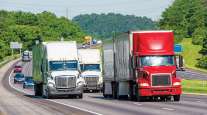DOT Projects Freight Gridlock Without Targeted Investments
 U.S. Department of Transportation
U.S. Department of TransportationBy Michele Fuetsch, Staff Reporter
This story appears in the Feb. 16 print edition of Transport Topics.
WASHINGTON — Trucks could move more than 80% of the nation’s freight in the coming decades, but the roads they travel and the ports and railheads they frequent could be gridlocked, according to a new federal study.
Without greater investment and better planning by the federal government and states, congestion could plague 37% of the National Highway System by 2040, compared with 11% in 2007, according to the yearlong study ordered by Transportation Secretary Anthony Foxx.
“The national government has an interest in the country being able to move freight freely, effectively, efficiently and safely,” Foxx said in an interview with Transport Topics on Feb. 12.
Highways are not the only piece of the freight network that are increasingly congested, Foxx said, citing his 300-page study.
“It’s multimodal congestion,” he said. “In the Midwest, there’s a lot of rail congestion. On the East and West coasts, there’s a lot of first- and last-mile congestion around densely populated areas, and there’s enough concern about our ability to home in and meet those needs under the current mechanism for funding transportation.”
The freight section of the study is a trumpet call for new federal investment strategies in critical freight corridors.
“Every year, trucks are losing $27 billion on wasted time and fuel,” said the study, titled “Beyond Traffic: Trends and Choices.” It is a 30-year outlook on transportation.
It warns that the U.S. multimodal freight system, “once the envy of the world,” is increasingly unable to meet the needs of a growing population and a changing economy.
A recurring theme of the freight section is to attack congestion by targeting money at highway bottlenecks in metropolitan areas, at ports and railheads and at border crossings, where trucks often are forced to idle.
Currently, federal highway funds are apportioned to states, not on an as-needed basis but by formulas based largely on population — a funding strategy Foxx said has to change.
“It’s time to break the mold,” he said. “As we look forward, I think states will welcome the opportunity to see a national freight program that is fully funded.”
Freight bottlenecks, such as those on the Brent Spence Bridge that connects Ohio and Kentucky, the Interstate 5 bridge that connects Oregon and Washington and the intermodal hubs in the Chicago area, are the types of projects that could get targeted funding, Foxx said.
He pointed to the “Projects of Regional and National Significance” program, created under the SAFETEA-LU reauthorization law but currently unfunded as a mechanism to funnel money to freight projects.
The way to target the money is to have states compete and to give the money to those that work together on regional projects, Foxx said.
“We’re looking for projects that would scale and create maximum impact on the movement of goods,” he said.
Another recurring theme is that “the nature and location of freight movements has shifted.”
Factories and farms now export their products, and manufactured goods are more likely to be imported, meaning trucks are increasingly concentrated in corridors that lead into and out of ports in urban locations, the report said.
“I think, in a lot of sections, [Foxx is] saying, ‘Look, we completed the interstate system, and now this is what’s facing us,’ ” said Norman Mineta, former Democratic representative from California and secretary of transportation under former President George W. Bush.
“I think his point is, if we don’t clear the ports and we have congestion in these major freight corridors, then from an economic perspective, we’re strangling ourselves,” Mineta added.
Foxx and the former secretary met the day the report was released with Northern California transportation leaders in a roundtable discussion of the study at the Mineta Transportation Institute in San Jose.
Foxx also touted the study at Google headquarters in nearby Mountain View, California, where he rode in a driverless car, an innovation highlighted in the study.
Emil Frankel, assistant secretary for transportation policy at DOT from 2002 to 2005, said the study is impressive for its emphasis on targeting freight money to specific projects.
“Implicitly, this report cautions about putting money in freight and just spreading it around like peanut butter, which isn’t going to do any good,” Frankel said.
Darrin Roth, vice president of highway policy for American Trucking Associations, said the study illustrates the problem the nation will face if it does not address future congestion.
“I think that going from 11% of the [National Highway System] to over 30% of the NHS congested should be eye-opening to a lot of people,” Roth said. “That suggests that, in the future, it’s not just large metro areas that will experience severe traffic congestion. It’s smaller cities and even some rural highways.”




